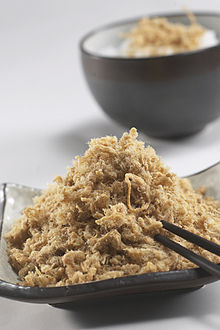Meat floss
 | |
| Alternative names | meat wool, meat floss, pork floss, flossy pork or pork sung |
|---|---|
| Place of origin | |
| Main ingredients | Pork |
| Meat floss | |||||||||||||||
|---|---|---|---|---|---|---|---|---|---|---|---|---|---|---|---|
| Chinese name | |||||||||||||||
| Traditional Chinese | 肉鬆 | ||||||||||||||
| Simplified Chinese | 肉松 | ||||||||||||||
| Hanyu Pinyin | ròusōng | ||||||||||||||
| Literal meaning | meat fluff/loose | ||||||||||||||
| |||||||||||||||
| Rousu | |||||||||||||||
| Chinese | 肉酥 | ||||||||||||||
| Hanyu Pinyin | ròusū | ||||||||||||||
| |||||||||||||||
| Rourong | |||||||||||||||
| Traditional Chinese | 肉絨 | ||||||||||||||
| Simplified Chinese | 肉绒 | ||||||||||||||
| Hanyu Pinyin | ròuróng | ||||||||||||||
| |||||||||||||||
| Vietnamese name | |||||||||||||||
| Vietnamese | ruốc (Northern Vietnamese) or chà bông (Southern Vietnamese) | ||||||||||||||
| Indonesian name | |||||||||||||||
| Indonesian | abon | ||||||||||||||
Rousong, also called meat wool, meat floss, pork floss, flossy pork, pork sung or yuk sung, is a dried meat product with a light and fluffy texture similar to coarse cotton, originating from China.[1] Rousong is used as a topping for many foods, such as congee, tofu, and savoury soy milk. It is also used as filling for various buns and pastries, and as a snack food on its own. Rousong is a very popular food item in Chinese cuisine and Taiwanese cuisine.
Production
Rousong is made by stewing cuts of pork in a sweetened soy sauce mixture until individual muscle fibres can be easily teased apart with a fork. This happens when the collagen that holds the muscle fibres of the meat together has been converted into gelatine.[2] The teased-apart meat is then strained and dried in the oven. After a light drying, the meat is mashed and beaten while being dry-cooked in a large wok until it is nearly completely dry. Additional flavourings are usually added while the mixture is being dry fried. Five kilograms of meat will usually yield about one kilogram of floss. [citation needed]
Pork-less versions


| Part of a series on |
| Chinese cuisine |
|---|
 |
Fish can also be made into floss (魚鬆; yú sōng), though initial stewing is not required due to the low collagen and elastin content of fish meat.
In Muslim majority Indonesia, beef floss is the most popular variant, and meat floss is commonly called abon. Malaysian Muslims make and consume meat floss made from chicken or beef called serunding, which is a popular delicacy during Ramadan and Eid al-Fitr.[3]
In Muslim majority Hausa cuisine, dambu nama is a dry shredded beef snack, similar to Rousong. It is fried and heavily spiced in its preparation.
Other versions
A very similar product is pork fu (肉脯; pinyin: ròufǔ; Pe̍h-ōe-jī: bah-hú), which is less fried and less shredded than rousong, and has a more fibrous texture.
See also
References
- ^ a b Grigson, Jane (January 1985), World Atlas of Food, Bookthrift Company, ISBN 978-0-671-07211-7
- ^ Vickie Vaclavik, Elizabeth W. Christian. "Essentials of Food Science". Springer, 2003, p. 169.
- ^ Thestar.com. "Thestar.com." Mum’s meat floss legacy. Retrieved on 2008-09-19.

